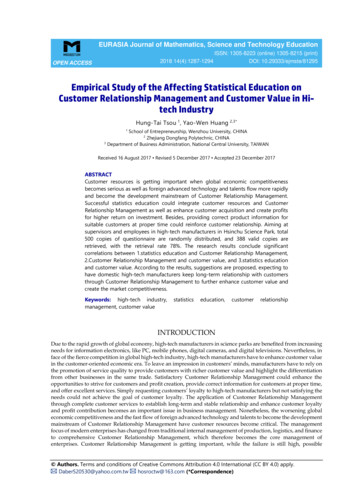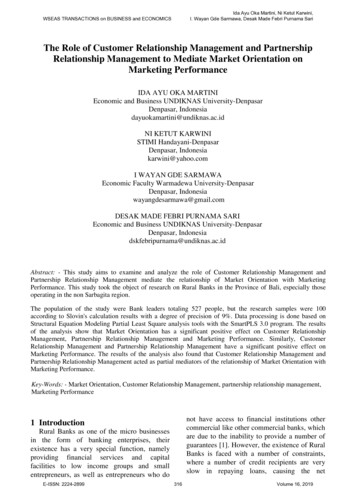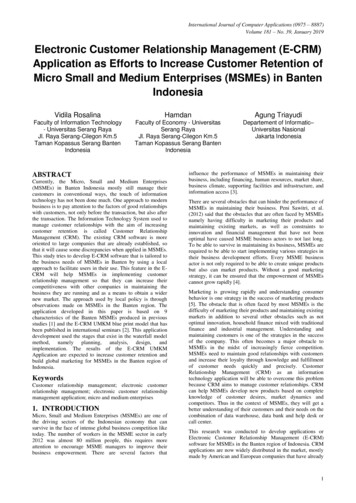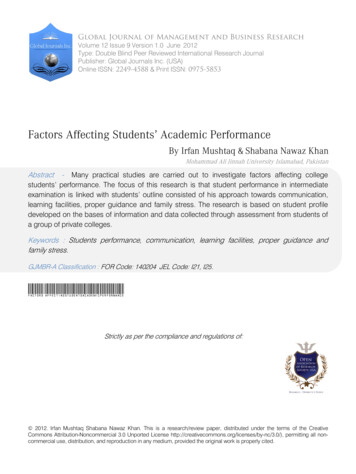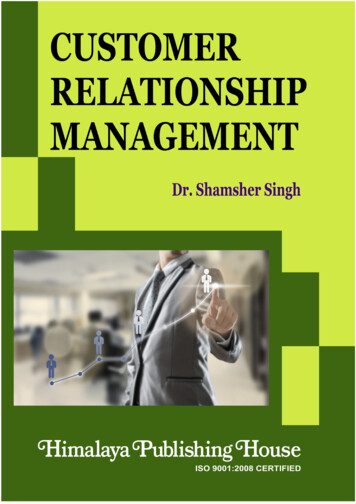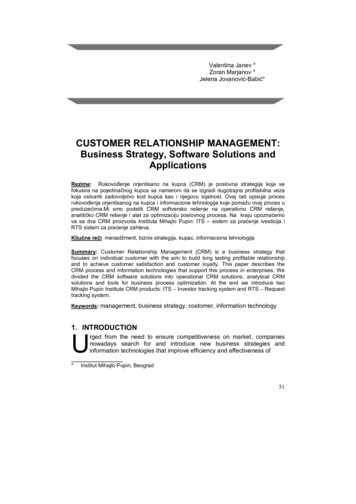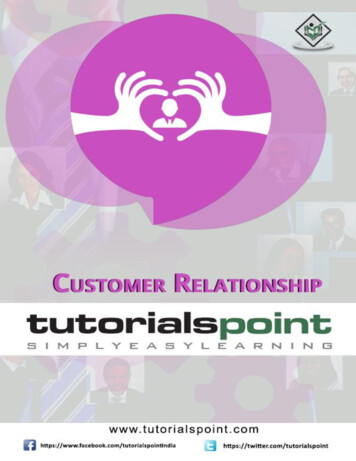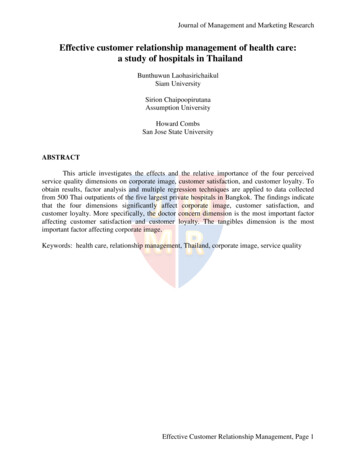
Transcription
The International Information & Library Review (2011) 43, 221e229Available online at www.sciencedirect.comjournal homepage: www.elsevier.com/locate/iilrFactors affecting customer relationshipmanagement practices in Thai academic librariesPiyawan Siriprasoetsin a, Kulthida Tuamsuk b,*, Cholabhat Vongprasert babDepartment of Information Technology, Maejo University, ThailandInformation and Communication Management Program, Khon Kaen University, ThailandKEYWORDSCustomer relationshipmanagement;CRM;Academic libraries;Thailand;Factor analysis;Library researchAbstract This study investigates and analyzes the factors affecting customer relationshipmanagement (CRM) practices in Thai academic libraries. The research conceptual frameworkfocuses on factors affecting CRM practices was developed using Combe (2004)’s study on assessing CRM strategies. Mixed methods, qualitative, and quantitative approaches were used asa research methodology. Data was collected by using the interview and survey techniques withthe administrators, staff and customers of six selected academic libraries in Thailand. Analysisof the data was done by using Pearson’s correlation coefficient, factor analysis, and multipleregression analysis. The results of the study show that factors that have statistically significantimpact on CRM practices in Thai academic libraries at 0.05 level were: (1) the knowledge andunderstanding of CRM of library staff and leadership of library administrators (Beta Z 0.762),(2) organizational culture and communication (Beta Z 0.323), (3) customer managementprocesses (Beta Z 0.318), (4) technology for supporting customer management(Beta Z 0.208), and (5) channels for library services and communications (Beta Z 0.150).The knowledge and understanding of CRM of library staff and leadership of library administrators which include the perception and awareness of service quality focusing on customer relationship is a key to library success. Important factors also include the acceptance and supportof the use of CRM in the library, the clear vision and mission about using CRM in the library strategic plan, the knowledge and understanding of library staff on CRM processes, customer characteristics, and behaviors. The organizational culture and communication factors involve thecreation of the CRM cultures of working in the library, good teamwork, cooperative and clearworking agreements, clear roles and responsibilities, good communication between librarystaff, cross library functional integration, and performance evaluation and development.The customer management processes factor includes recording and registration of customerprofiles, customer analysis and classification, services to individual customers, services to expected customers, and continual customer interactions. The technology for supporting CRMfactors includes communication technology, information technology, and operations supporttechnology. The channels for library services and communications factors can be direct channels, such as a service counter and self-circulation service, and indirect channels such as telephone, call center, email, personal web, library web, and social networking technology.* Corresponding author.E-mail address: kultua@kku.ac.th (K. Tuamsuk).1057-2317/ - see front matter ª 2011 Published by Elsevier Ltd.doi:10.1016/j.iilr.2011.10.008
222P. Siriprasoetsin et al.Suggestions for academic libraries on the development and implementation of CRM in librariesare: (1) CRM must be included in the library strategic plan; (2) CRM must be a key strategy forthe improvement of library service quality; (3) library administrators must have strong leadership for achieving the effectiveness of CRM practices in the library; (4) library staff must havegood knowledge and understanding of CRM and its link to the library service quality improvement; (5) the working cultures for CRM effectiveness such as teamwork, cross functional work,and good communication between staff must be encouraged and practiced in the library; and(6) technology must be fully supported for CRM in the library.ª 2011 Published by Elsevier Ltd.IntroductionAcademic libraries are currently facing their greatestchallenge due to the explosion in tertiary education andacademic publications. The alliance of business anduniversities to create a new paradigm of tertiary education,and the emergence of the virtual university, supported bythe virtual library, call into question many basic assumptions about the role of the academic library and the security of its future. Retaining and improving their customerdatabases and focusing on meeting their customers’expectations are the only ways for academic libraries tosurvive in this volatile competitive environment (Cullen,2001). Competition for customers and resources as well asrecognition that the library may no longer be the primarynor the only information source available bring newmeaning to the need to promote the library’s value ina crowded arena (Stueart & Moran, 2007). The reviews ofliterature revealed that customer relationship management(CRM) has been studied and used as part of library strategies for improving the quality of library services. This isbecause CRM is a widely-implemented strategy formanaging organizational interactions with customers. Itinvolves the processes of finding, attracting, and retainingnew customers, nurturing and retaining customers theorganization already has, enticing former customers backinto the fold, and reducing the costs of marketing andcustomer service. The overall goals of CRM are to createcustomer satisfaction, trust, loyalty, and retention(Gartner Inc., 2009; Gronroos, 2000; Tiwana, 2001).Recently, there has been increasing interest among Thaiacademic libraries in using CRM for library servicesimprovement as seen in meetings and conferences thataddressed applications of CRM in academic libraries andCRM benefits. The research from Roles of UniversityLibraries in Enhancing the Students’ Learning done fiveyears ago by Tuamsuk, Tulyasuk, Sarawanawong andDadphan (2005), also suggested that Thai academiclibraries had urgent needs to provide more proactiveservices and integrate the CRM strategy for improving thelibrary services. However, the study by Siriprasoetsin,Tuamsuk, and Vongprasert (2010) found that most Thaiacademic libraries had no policies on the creation andretention of good relationships with customers. Althoughthere were CRM practices found in some academic librariessuch as a study of customers’ attitudes and needs, creationof customers’ profiles, and provision of several options forcustomers’ communication, most of these practices wererelated to the traditional library services such as circulation, inter-library loan, and current awareness services.There were few innovative services focusing on customersin Thai academic libraries.Application of CRM in libraries will add value to libraryservices. It creates confidence and satisfaction among usersand will in turn increase the number of users and at thesame time bring back former users (Broady-Preston, Felice,& Marshal, 2006; Wang, 2007). However, successful CRMapplication also depends on a number of factors. Anyorganization wishing to use it has to understand the variousfactors in the CRM paradigm in order to establish theframework and mission (Chen & Popovich, 2003). Manyacademics have studied and compiled factors underlyingthe success of CRM administration and listed the followingas major contributors: information technology, staff,customers, customer management, organizational culture,leadership, organizational strategies, and teamwork(Buttle, 2004; Chen & Popovich, 2003; Combe, 2004). Infact, these factors are the outcome of the CRM administration studies conducted in business organizations. Thereis currently no study conducted on successful CRM-basedadministration for library organizations, especiallyacademic libraries which are categorized as non-profit andclassify customers as users. The researchers believe CRMadministration is a new issue for Thailand and hence, wishto study it in depth and holistically in order to obtainaccurate and practical academic information. This study isone part of the research into the development of a CRMmodel for Thai academic libraries.Research objectiveThis research investigates and analyzes the factorsaffecting CRM practices in Thai Academic Libraries.Literature reviewCustomer Relationship Management is a concept that isbased on the philosophy of using a combination ofcustomers and marketing for relationship building (Kotler,2003). Gronroos (2000) defined CRM in service marketingas a communicating process between customers and anorganization’s service in order to attract and maintainthose customers who will be the organization’s truecustomers who are using the organization’s services. These
Factors affecting customer relationship management practicescustomers also have a tendency to pay willingly for theorganization’s services at a higher price.The factors behind the success of CRM include items thatdrive a successful implementation which become the keycomponents underlying the success of CRM (Rajola, 2003).Many academics have conducted studies and proposedimportant components of CRM. Buttle (2004), for instance,stated that there are four important factors affecting thechain values of CRM, namely, leadership and organizationalculture, people, data and information technology, andprocess. Similarly, Chen and Popovich (2003) suggested thatthe key factors for CRM are people, technology, andprocess. However, all four strategies and implementationprocesses, customer-centric business process, enterprisewide strategy, technology-driven process, and cross functional integration must have momentum to move forward.Combe (2004) proposed the following four items for drivingforth CRM: culture, leadership, people, and technology.There are others academics, both Thais and foreigners, whoconducted studies on factors leading to CRM success. Theresearcher has synthesized the findings of these studies intothe following conceptual framework.Knowledge & understanding of CRM of library staffand leadership of library administratorsThis factor mainly involves people, or the administrators ofthe libraries who set the policies and are responsible foradvancing CRM toward success. The administrators shouldhave leadership capacity meaning they understand andknow CRM well. They should be able to establish the visionand lead the organization by efficiently introducing CRM, beresponsible for developing CRM strategies, and driveimplementation by creating CRM support mechanisms suchas resources, time, working environment, and technology.They should be able to remove obstacles or problems thatwill hinder the administration from reaching the expectedgoals (Combe, 2004). Staff should be informed of andunderstand CRM and organizational visions and strategies,aware of customer-oriented service values, and knowledgeable about the outcomes from the creation andmaintenance of good relationships between customers andthe organization (Greenberg, 2001).Organizational culture and communicationOrganizational culture originated and is accumulated frombeliefs, expectations, attitudes, and common values of allmembers. All of these aspects result in cooperativelearning, acceptance, and successful implementation inorder to attain the organizational aims which are thentransferred to future generations (Noppakhun, 1998;Wheelen & Hunger, 2000). As far as CRM administration isconcerned, it can be said that organizational culture andcommunication are the most difficult factors to overcomesince the administrators need to change attitudes andencourage the personnel to accept new concepts in CRM.Moreover, this involves the building of a working culture,establishing agreement for cooperation, building teamworkconsisting of people of various disciplines that takedifferent roles, creating integrated cooperation, and223communicating efficiently; all of which require personnelparticipation at all levels ranging from administrators tooperators (Mendoza, Marius, Prez & Griman, 2006; Stone,Woodcock, & Machtynger, 2001).Customer management processesThe processes of customer management are the mostimportant factors supporting the introduction of CRM inorganizations. The process commences from getting toknow customers and building good relationships withcustomers based on the behaviors of targeted groups(Nykamp, 2001). An organization needs to make a customerinventory as the foundation for relationship buildingthrough the construction of complete customer databasesthat are accessible by the organization. Each customeraccount should be analyzed in order to understand his orher need and attitudes, which are the basis for good relationship building and ongoing relationships maintenance(Stefanou, Sarmaniotis, & Stafyla, 2003). The customermanagement processes cover recording and registeringcustomer accounts, analyzing customer accounts forimproved customer understanding, providing services tolibrary customers, preparing for expected customers,interacting continuously with customers, and arrangingother activities (Combe, 2004; Ho & Chuang, 2006; Mendozaet. al., 2006; Zablah, 2005).Technology for supporting customer managementNowadays information technology and communication areused as the tool for organizational communication, knowledge management, and strategies (Laudon & Laudon,2002). Likewise, CRM technology is an important strategictool of an organization to attain success in CRM application(McKie, 2001; Stefanou, Sarmaniotis, & Stafyla, 2003) dueto the basic structure of information technology andinformation from customers’ databases (Torres, 2004).Primarily, the customer management strategy requiresa central repository to store all customer news and information. This central repository must have an efficientinformation technology architecture that is adjustableaccording to the changing environment (Buttle, 2004;Combe, 2004). It must contain a systematic CRM in orderto communicate with customers through the direct dispatchof information to customers which is a strategy for retainingan organization’s customers (Steffes, 2005). The quality ofinformation sent to customers also affects relationshipbuilding with customers. In this respect, the application oftechnology can upgrade the quality of information dispatched to the customer (Zablah, 2005). It can beconcluded that the successful CRM includes coordinatingtechnology, operational technology, and analytical technology (Ho & Chuang, 2006; Mendoza et al., 2006; Zablah,2005).Channels for library services and communicationsChanneling interactions and communication appropriate forcustomers is very important for building and maintainingrelationships. There are a number of possible interaction
224channels and communication means, namely, direct marketcommunication, face-to-face communication, and indirectmarket communication by means of telephone or internetnetwork. Interactions through the various channels increasethe relationship between the organization and itscustomers, with the former being able to provide suitableservices that directly meet the latter’s needs (Kotler,Roberto, & Lee, 2002). Appropriate communication withcustomers, notwithstanding whether it is selling or providingservices in situ, at the telephone center, on the websites, atthe customer service point, or through advertisement, cansatisfy customers and result in customer loyalty (Nykamp,2001). Additionally, the service channeling factor corresponds to the innovative library concept that suggests theaddition of information processes through regular surveys,increase of multiple information characteristics, andincrease of means for information access based on convenient information technology and perceived speed ofinformation, will assist in lessening budget expenditure(Stueart & Moran, 2007).Research methodologyThis study applied a mixed research method which includedboth quantitative and qualitative means. The research sitewas academic libraries of public universities affiliated withthe Office of Higher Education Commission of Thailand. Thesample was selected through purposive sampling byconsidering six university libraries with readiness and highinformation technology potential. Two population groupswere chosen with one comprising administrators and librarystaff and the other consisting of library customers whowere lecturers from each academic institution. Informationwas collected through a questionnaire and interviewsduring the JuneeOctober 2009 time frame. From the 130library personnel, 125 (92.00%) responded, whereas 342customers (89.00%) from the total of 385 provided information from the second population group. The data wasstatistically analyzed to determine percentages, means,standard deviations, and multivariate analysis.ResultsImpacts on CRM in academic libraries as seen by thelibrary personnelThe analysis of overall impacts of CRM in academic librariesas seen by library personnel indicates that the factoryielding the highest impact was the channels for libraryservices and communications (77.4%). The factors withmedium impact were the knowledge and understanding ofCRM of library staff and leadership of library administrators(54.2%) and customer management processes (54.2%). Thefactors with little impact were the technology for supporting customer management (48.8%) and organizationalculture and communication (37.6%).The analysis of sub-factors affecting CRM shows thata direct channel for communication with customers was thefactor seen as having the highest impact (77.4%). Thefactors with medium impact were services to individualcustomers (72.8%), perception and awareness of serviceP. Siriprasoetsin et al.quality focusing on customers (66.4%), and continualcustomer interactions (63.2%). The factors receiving thelowest opinion level with over 50% of respondents includedcustomer-oriented activities (58.4%) and communicationtechnology (54.4%). Some respondents (41.6%) believedthat creation of CRM teamwork had no impact on CRM(Table 1).Impacts on CRM in academic libraries as seen by thelibrary customersThe analysis of the overall impacts on CRM in academiclibraries as seen by library customers reveals that thefactors yielding the highest impact were the channels forlibrary services and communications (66.1%), followed byorganizational culture and communication (53.6%) andtechnology for supporting customer management (52.7%).The factors with medium impact were the knowledge andunderstanding of CRM by library staff and library administrator leadership (46.6%) and the customer managementprocesses (27.3%).The analysis of sub-factors affecting CRM shows thatchannels for library services and communication had thehighest impacts with the direct channels at 72.2% andindirect channels at 64.0%, followed by communicationtechnology (61.4%) and cross library functional integration(60.5%). The factors receiving medium opinion wereperception and awareness of service quality focusing on thecustomer (61.7%) and performance evaluation and development of the library culture (50.9%). The factor with lowimpact in CRM was services to individual customers (48.0%).The factor seen as not having any impact was customerclassification (48.0%) (Table 1).Analysis of factors affecting CRM in academiclibrariesThe analysis of factors affecting CRM in academic librarieswas conducted based on multivariate analysis and multipleregression analysis. The independent variables included fivefactors, namely, (1) knowledge of CRM and leadership; (2)organizational culture and communication; (3) customermanagement processes; (4) technology supporting customermanagement; and (5) service channels and communication.CRM was the dependent variable. The factor reported ashaving highest impact on CRM was knowledge of CRM andleadership (Beta Z 0.762), followed by organizationalculture and communication (Beta Z 0.323), customermanagement processes (Beta Z 0.318), and technologysupporting customer management (Beta Z 0.208). Thefactor least affecting CRM was service channels andcommunication (Beta Z 0.150) (Fig. 1). The detail of eachfactor is provided in Table 2.1.1. The analysis on knowledge and understanding of CRMand leadership shows that all sub-factors in this category explain CRM in academic libraries at a significancelevel of 0.05. The variation of CRM in these libraries isexplained at 36.6% (Adjusted R2 Z 0.366). There wasone sub-factor having a statistically significant positiveimpact which was the understanding, acceptance, and
Perspectives of the library staff and customers on factors affecting CRM effectiveness in academic libraries.Factors affecting CRM effectivenessPerspectives of library staff no. (%)High1. Knowledge & understanding of CRM of librarystaff and leadership of library administrators1.1. Perception and awareness of service qualityfocusing on customer relationship is a key tolibrary success.1.2. Acceptance and support of use of CRM inthe library1.3. Clear vision and mission about using CRMin the library strategic plan1.4. Knowledge and understanding of librarystaff on CRM processes1.5. Knowledge and understanding of customercharacteristics and behaviorsMode-rate LowNonePerspectives of library customers no. (%)TotalHighMode-rate LowNoneTotal26 (20.5) 4 (3.2)125 (100) 146 (42.8) 159 (46.6) 33 (9.7)3 (0.9)342 (100.0)21 (16.8) 83 (66.4)20 (16)125 (100) 105 (30.7) 211 (61.7) 24 (7.0)2 (0.6)342 (100)26 (20.8) 58 (46.4)31 (24.8) 10 (8)125 (100) 163 (47.7) 137 (40.1) 37 (10.7)5 (1.5)342 (100)25 (20)69 (55.2)27 (21.6) 4 (3.2)125 (100) 166 (48.5) 141 (41.2) 31 (9.1)4 (1.2)342 (100)38 (30.4) 67 (53.6)18 (14.4) 2 (1.6)125 (100) 161 (47.1) 146 (42.7) 33 (9.6)2 (0.6)342 (100)28 (22.4) 62 (49.6)32 (25.6) 3 (2.4)125 (100) 137 (40.1) 162 (47.4) 41 (12.0)2 (0.6)342 (100)2. Organizational culture and communication2.1. Creation of the CRM teamwork2.2. Clear cooperative working agreements2.3. Clear roles and responsibilities2.4. Good communication between library staff2.5. Cross library functional integration2.6. Performance evaluation and development14 (11.3)6 (4.8)41 (32.8)7 (5.6)2 (1.6)4 (3.2)25 4)(42.4)35 (27.9)52 (41.6)7 (5.6)47 (37.6)49 (39.2)46 (36.8)8 2342342342(100)(100)(100)(100)(100)(100)(100)3. Customer management Processes3.1. Recording and registration of customer profiles3.2. Customer analysis3.3. Customer classification3.4. Services to individual customers3.5. Services to expected customers3.6. Continual customer interactions3.7. Customer-oriented activities19 (15.2)30 (24)24 (19.2)13 (10.4)14 (11.2)37 (29.6)13 (10.4)2 38.4)(15.2)(23.2)(24.8)(58.4)12 (9.4)3 (2.4)8 (6.4)35 (28.0)1 (0.8)8 (6.4)2 (1.6)25 00)(100)(100)(100)91 (26.7)150 (43.8)3 (0.9)2 (0.6)3 (0.9)144 (42.1)182 (53.2)156 (45.6)68 (20.0)2 (0.6)163 (47.6)164 (48.0)139 (40.6)4 (1.2)5 (1.5)2 100)(100)(100)(100)4. Technology for supporting customer management4.1. Communication technology (telephone, web page,call center, hot line, etc.)4.2. Information technology (database, data mining,knowledge management system)4.3. Technology for operating support (SFA-serviceforce automation system, marketing automation,financial operation system)11 (8.8)8 (6.4)38 (30.4)47 (37.6)61 (48.8) 15 (12.0) 125 (100) 180 (52.7) 101 (29.6) 50 (14.7)68 (54.4) 2 (1.6)125 (100) 210 (61.4) 41 (12.0) 74 (21.6)10 (2.9)17 (5.0)342 (100)342 (100)19 (15.2) 26 (20.8)60 (48)20 (16)3 (0.9)342 (100)6 (4.8)55 (44)23 (18.4) 125 (100) 176 (51.5) 115 (33.6) 41 (12.0)10 (2.9)342 (100)7 (1.9)3 (0.9)342 (100)342 (100)10 (2.9)342 (100)41 (32.8)5. Channels for library services and communications79 (63.0) 13 (10.4)5.1. Direct channels (service counter, self circulation97 (77.4) 13 (10.2)service)5.2. Indirect channels (telephone, call center, email,61 (48.6) 13 (10.5)personal web, library web, social networking tech., etc.)1 (0.8)24 (19.1) 9 (7.5)11 (8.48 4 7)(50.9)93 (27.3)158 (46.2)25 (7.3)16 (4.7)36 (10.5)137 (40.1)125 (36.5)156 (8.7)89 (26.0)32 (9.4)151 (44.2)160 (46.7)164 (48.0)57 (16.6)30 (8.8)28 (8.2)125 (100) 155 (45.3) 148 (43.3) 36 (10.5)125 (100) 233 (68.1) 89 (25.9)125 (100) 247 (72.2) 76 (22.2)14 (4.2)16 (4.7)37 (29.7) 14 (11.2) 125 (100) 219 (64.0) 101 (29.5) 12 (3.6)(0.9)(1.2)(0.6)(0.6)(0.6)(0.9)(1.5)22528 (22.1) 68 (54.2)Factors affecting customer relationship management practicesTable 1
226P. Siriprasoetsin et al.Organizational culture and communication9.169Channels for library services andcommunicationsKnowledge & understanding of CRM oflibrary staff and Leadershipoflibrary administrators4.271*21.630*CRM in ThaiAcademicLibraries9.035*Customer management Processes*5.902Technology for supporting customermanagement2R 0.852Figure 12Adj R 0.846F 137.331Sig. of F 0.000Model of factors affecting customer relationship management.support of CRM. It is predicted that an increase of oneunit of this sub-factor will increase 1.561 units of CRMin academic libraries, with the sub-factor impact valueof 0.437 (Beta Z 0.437). We were able to concludethat the understanding, acceptance, and support ofCRM are related to university library CRM.These findings correlated to a number of literature andresearch studies, for example; Anderson and Kerr (2001);Combe (2004); Ho and Chuang (2006); Mendoza et. al.(2006); and Torres (2004). These studies proved that organizational administrators, staff, and operators must haveCRM knowledge and understanding to make building andmaintaining relationships with customers a success.1.2. The analysis of organizational culture and communication in libraries indicates that all sub-factors in thiscategory can be explained in academic libraries withCRM at a statistical significance level of 0.05. Theanalysis was able to explain the variation of academiclibrary CRM at 30.0% (Adjusted R2 Z 0.300). There wasone sub-factor in this category that had a statisticallysignificant positive effect on CRM which was intercommunication. It is predicted that with an increaseof one unit of this sub-factor, the CRM of academiclibraries would increase at 9.072 units, with the subfactor impact value of (Beta Z 0.251). It isconcluded that inter-communication between librarystaff is correlated to university library CRM.Our findings correlate to a number of research studies,for example, Combe (2004); Gartner Inc. (2009); Ho andChuang (2006); Mendoza et. al. (2006); Stone, Woodcock,& Machtynger (2001). All of these studies report thatsuccessful application of CRM in an organization requiresinter-communication among the members.1.3. The analysis of customer management shows that all ofthe sub-factors in customer management were able toexplain CRM in academic libraries at a statistical significance level of 0.05. The variation of CRM in these librarieswas as high as 91.5 percent (Adjusted R2 Z 0.915). Foursub-factors in this category were found to be statisticallysignificant in terms of positive impact, namely, arrangement of activities for customers, customer services,continuous customer interaction, and recording andregistering customer accounts. It could be predicted thatan increase of one unit of these sub-factors wouldincrease CRM of academic libraries to 1.813, 1.476,1.539, and 0.913 units, respectively.The comparison of the impact from the four sub-factorsrevealed that the arrangement of activities for customershad the greatest impact on a library’s CRM (Beta Z 0.490),followed by customer services (Beta Z 0.257), continualinteraction with customers (Beta Z 0.240), and therecording and registering of customer accounts(Beta Z 0.223). We concluded that the sub-factors incustomer management processes, arrangement of activitiesfor customers, customer services, continuous customerinteraction, recording and registering customer accounts,correlate with academic library CRM.This correlates to a lot of research work and literature,for example, Combe (2004); Mendoza et al. (2006); Nykamp(2001); Stefanou, Sarmaniotis, & Stafyla (2003); Tiwana(2001) and Torres (2004). These studies proved thatcontinuous activities, services, and recording and registering customer accounts contribute to success in maintaining good relationships with customers.1.4. The analysis of customer management technologyshowed that all of the technology-related sub-factorsexplained CRM in academic libraries at the significancelevel of 0.05, with the variation of CRM being 28.6%(Adjusted R2 Z 0.286). There were two sub-factors withstatistically significant positive influences which werecoordination technology and analytical technology. Itcould be predicted that when these sub-factors increaseone unit, CRM of academic libraries would increase at1.649 and 4.811 units, respectively. When the two subfactors were compared in terms of their impact, it wasfound that the coordination of technology showed thehighest impact on academic library CRM (Beta Z 0.371)followed by analytical technology (Beta Z 0.290). It wasconcluded that the coordination of technology andanalytical technology related to academic library CRM.
Factors affecting customer relationship management practicesTable 2227Factors Analysis on CRM practices in Thai academic libraries.FactorsCustomer relationship managementB1. Knowledge & understanding of CRM of librarystaff and leadership of library administrators1.1. Perception and awareness of service qualityfocusing on customer relationship is a key to library
The factors behind the success of CRM include items that drive a successful implementation which become the key components underlying the success of CRM (Rajola, 2003). Many academics have conducted studies and proposed important components of CRM. Buttle (2004), for instance, stated that there are four important factors affecting the
